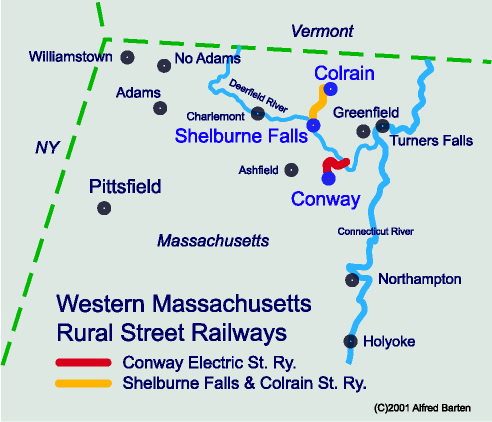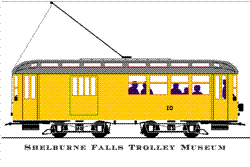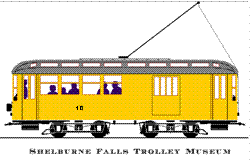
Shelburne Falls Trolley Museum



Two local trolley lines were the Shelburne Falls and Colrain Street Railway (SF&C) and the Conway Electric Street Railway (CESR).
The SF&C was the line that built the bridge now known as the "Bridge of Flowers" and that operated the trolley car that we restored and operate in season, SF&C No. 10. You can read about the SF&C in the article below by Al Barten, or in this webpage by Al Barten or in the Transportation Bulletin No. 75, found here as a pdf.
We also have collection of pages by Al Barten on the Conway Electric Street Railway.
To read summaries of local town histories, visit the
Massachusetts Historical Commission web site.
The Buckland, Shelburne and Colrain reports include information about
the SF&C St Ry and related industries.
Shelburne Falls Village, set on the banks of the Deerfield River at Salmon Falls and framed by the surrounding rugged hills of northwestern Massachusetts, is home to the Shelburne Falls Trolley Museum. The non-profit educational organization is based in the old Boston & Maine freight yard (click here for aerial view). This yard overlooks the "glacial" potholes and the former trolley bridge better known today as the Bridge of Flowers. This local landmark, now famous for its floral displays, was built in 1908 by the Shelburne Falls & Colrain Street Railway to give the line a physical link to the Boston & Maine and New York, New Haven & Hartford railroads at their station on the Buckland side of the Deerfield River. Models, photos, artifacts, and videos at the museum illustrate the area's rich railway history.
The museum's chief asset is the SF&C combination passenger-baggage car No. 10. The car body was donated to the museum in 1992 by Marshall Johnson, whose father purchased it in 1928 after the trolley company ceased operations. On October 9, 1999, restored No. 10 made its formal return to operation amid a gala festival held to honor the car, its donor, and the many volunteers and professionals who helped make an impossible dream a reality.No. 10 is relatively well known among trolley enthusiasts. Drawings of it were published in Model Railroader (April 1970) and in the Connecticut Valley Chapter of the National Railway Historical Society' s Transportation Bulletin No. 75, (1967- 68). (The latter publication includes a detailed history of the SF&C and the Bridge of Flowers, and is sold at the Museum's TrolleyStop giftshop.) Brass models of this attractive car were made by Fomras of Japan and imported in recent years. With an overall length of 32'-9", No. 10 is one of the smallest eight-wheel interurban combination cars ever built in the United States.
The car was built by the Wason Manufacturing Company of Springfield, Massachusetts, in 1896, the year the SF&C was opened. It was considered state-of-the-art at the time, having electric heaters and lights. Wason was noted for building streetcars used throughout New England and other eastern states and for building the first 400 cars of the Manhattan Elevated in New York City after that line was electrified. Wason also built standard railroad coach and sleeper cars and did a good export business to South America and the Orient. The company built all its parts except for motors and, in World War I, even built airplanes for the war effort. Wason was acquired by the J.G. Brill Company of Philadelphia in 1907 but retained its corporate identity until its closing days in 1931-32.
No. 10 was inspected in April 1991 by Kinsley Goodrich of Dalton, (click here for picture) a professional woodworker with a longtime interest in trolleys and experience in operating and providing milled wood components for trolleys at the Connecticut Electric Railway Museum in Warehouse Point. The car was found to be in relatively good shape, considering its long inactivity, its age, and conditions of storage. Rainwater had for the most part been kept out of the interior by metal roofing material on the lower roofs and roofing paper over the clerestory roof. Some of the interior paneling, trim, benches, and floor boards had to be refinished; the rest was rebuilt. Hidden posts in the side walls were generally in good condition. Part of one side sill, window sills and sash, and the roof had to be replaced.
Old tires and concrete blocks had been piled on the roof (click here for picture) to hold down the roofing paper. The resulting weight caused some distortion to the body lines, but this has been straightened by shimming at key points. The baggage-end vestibule was badly rotted and needed complete rebuilding.
Trolley Days on the Shelburne Falls & Colrain Street Railway Co.
The SF&C was a seven-mile rural trolley line between Shelburne Falls
and Colrain, Massachusetts. It ran from late 1896 through most of 1927. A pronounced
downturn in the company's financial picture, the decision of a major
freight customer to go to trucks and a determination by the
state to rebuild Route 112 along North River to Colrain, which would
have forced otherwise unnecessary and expensive track relaying in that
section, brought on the company's demise.
Like other rural trolley lines, the SF&C provided area residents, farmers, and manufacturers a much-needed social and commercial connection to the outside world via the railroad in the days before automobiles and paved roads became commonplace. The era of the rural trolley--the 1890s to the 1920s--was filled with excitement over the advances of new technologies and the freedom and opportunities they promised. Trolley building, or "trolley fever," spread across the country like wildfire through the '90s and into the next decade. Towns everywhere sought the advantages that the "electrics" offered riders and shippers, not to mention promoters and investors who anticipated great gains from the industry' s spectacular growth. Just as quickly, though, the era ended as post-World War I inflation, mass-produced automobiles, and municipally financed paved roads forced many trolley companies into bankruptcy. The SF&C was as close to prototypical as a rural trolley line could be, considering the highly individualistic nature of the species.
Initially, the SF&C ran north from the village of Shelburne Falls, on the north side of the Deerfield River, to the town of Colrain where it served several mills. All incoming freight had to be unloaded from railroad cars at the joint Boston & Maine- New Haven railroad station in the town of Buckland on the south side of the river and carted by horse and wagon over an iron highway bridge to Shelburne Falls. Here the freight was transferred again to the trolley company's freight cars--a collection of four-wheel flat and box cars--for final delivery. Outgoing freight followed the reverse procedure.
A 20-ton weight limit on the iron highway bridge discouraged the Buckland selectmen from permitting trolleys to use the bridge as a way to reach the steam roads on their side of the river, though the Shelburne selectmen for their part saw no difficulty. The cumbersome procedure of transferring freight to horse-drawn carts for the river crossing lasted until 1908, when the SF&C completed its own bridge across the Deerfield.
The new bridge, built largely by Italian labor recruited in New York City, was impressive by any standards. The five-span arched structure was built of poured concrete and designed to support the heaviest rolling stock then in use on the steam roads. It spanned the river at an angle and was 398 feet long. The cost of over $20,000 was about equal to the amount that would have been saved in teamster charges for transshipment had the bridge been built in the first place.
Once able to cross the river on its own, the SF&C established a direct connection with the steam roads, building a siding and a freight house near the main depot. The line acquired No. 25, a heavier combination car equipped with knuckle couplers to haul standard railroad freight cars. The new combine routinely pulled one, sometimes two, 40-ton freight cars to and from Colrain on its daily rounds. Some of the bridges on the line had to be strengthened to accommodate the heavier freight cars.
As well as moving shipments to and from the mills along the line, the SF&C carried many cans of milk and barrels of apples, cider, and vinegar. The milk was reloaded into special milk tank cars at the rail yard for final express delivery by the steam roads. SF&C passenger traffic was also substantial. In 1913, its peak year, the line carried nearly 243,000 people and collected just over $12,000 in revenue from the service. Twelve round trips were scheduled per day between the terminal towns. When traffic demanded, extra cars were put on. Sometimes non-scheduled specials were also run. Scheduled trips varied from 35 to 43 minutes each way but could easily take an hour. The line's informality permitted a motorman to backtrack, for instance, so that a passenger could run home for something left behind. Loading packages into the combination cars and coupling/uncoupling freight trailers (or railroad cars in later years) could also delay a trip.
Trolley companies often developed out-of-town parks as a way of encouraging traffic. No exception, the SF&C leased some land about halfway up the line and established a picnic grove. Hillside Park, as it was known, became a popular place for summer band concerts, recreational outings, and sporting events such as baseball games. Just riding in an open car on a hot summer day or eve was a joy in itself. The line also carried mail, with pickup and delivery three times a day at communities along the route.
Originally the SF&C generated its own power with a small combination hydro-electric/steam plant at Frankton, north of Shelburne Falls. When plant equipment wore out in the mid-twenties the company purchased electricity from the New England Power Company. The SF&C also owned a ticket office in Shelburne Falls and three car barns--one each at Shelburne Falls, the Frankton powerhouse, and Colrain.
Besides the two combination cars, the SF&C operated two 9-bench, four-wheel open cars; a 12-bench, eight-wheel open car; two closed eight-wheel cars; and three former horse cars, one converted to power, the rest used as trailers. A total of nine four-wheel trailer cars served the freight business before steam road cars could be hauled. A four-wheeled motor served as both a locomotive and snowplow. All cars except No. 10 and No. 25 were purchased second-hand.
In 1911, the SF&C projected an extension to Wilmington, Vermont. The town was served at that time by the Hoosac Tunnel & Wilmington Railroad (affectionately known as the "Hoot, Toot & Whistle"), a ten-mile narrow gauge steam road that linked this southern Vermont community to the B&M at Hoosac Tunnel, Massachusetts. A proposed dam project, which threatened to submerge the already troubled road's right-of-way, encouraged the SF&C extension. Surveys were made but all came to naught when new money was found from interests in North Adams to convert the HT&W to standard gauge and plans for the dam were abandoned.
If the trolley offered a new-found freedom, the automobile offered more of it. America's romance with the trolley turned to outright love for the auto in the 1920s, and the SF&C's fortunes, never great by any measure, turned to desperation. After 1917 the line's income exceeded expenses only twice. In 1927 the company could no longer meet its obligations and was forced to cease operations. It was sold at a foreclosure sale in 1927 for $11,500 and scrapped the following year.
Today No. 10 is the only piece of SF&C rolling stock in existence. The railway's buildings and structures have fared a little better. Still standing is the freight house and yard at Shelburne Falls, preserved as part of the museum's operations. The former maintenance shop along Route 112 is a home, the ticket office in Shelburne Falls still stands at the Shelburne end of the Bridge of Flowers. Recently, a former coal trestle at the foundry in Lyonsville was mostly demolished.
Most of the old right-of-way is still clear. One can follow it northward along Route 112 and the North River through Griswoldville and Lyonsville to Colrain. Shortly after the line's abandonment, the concrete bridge achieved fame of its own as the Bridge of Flowers. Every summer the Shelburne Falls Women's Club lines the bridge with an extensive floral display, making Shelburne Falls a popular tourist stop along Massachusetts Route 2, the Mohawk Trail. The bridge itself looks much as it did in its trolley days, having undergone a facelift and repair work in 1984.
Shelburne Falls and Buckland have retained their l9th-century Victorian flavor, which contributes to the locale's appeal. Add to this some potholes (large holes in the rock ground by other stones and water) in the gneiss below Salmon Falls, artisans' showrooms, restaurants and many antique shops, and you have a perfect setting for a restored vintage trolley reunited with the bridge it once traversed and the town it once served.
14 Depot Street Shelburne Falls MA 01370 413-625-9443 trolley@sftm.org